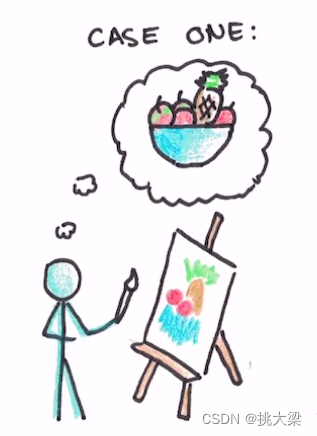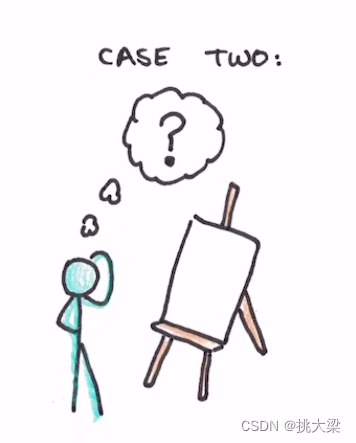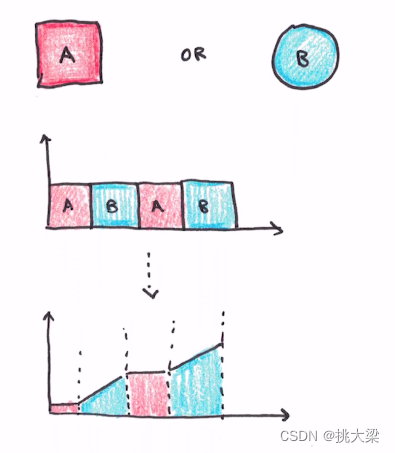A lot of learing involves having a mental representation of what the ideal performance ought to be, a method or approach to achieve said performance, and then working towards implementing that method with your mind.
许多学习都需要先有一个心理表征,知道理想的表现是什么样的,用什么方法或手段来达到那种表现,然后努力在心里运用那种方法。
There are therefore two distinct problems you can encounter when you’re trying to learn something.The first is that you have a clear picture of what you’d like to do, and how you’re going to do it, but you’re simply unable to implement the approach you’ve chosen.In these cases, slowing things down is usually beter.By slowing down the speed of the overall process you can devote more attentions to each aspect of the problem.Only once you’re able to do it correctly does it make sense to ry to do it faster.Rushing this only results in making mistakes.
因此在试着学习某件事时,你可能会遇到两种不同的问题。第一种是你清楚地知道自己要做什么,以及要怎么做,但就是无法运用选定的方法。在这种情况下,放慢速度通常会有好的效果。通过放慢整个过程的速度,你可以给予问题的各个方面更多关注。只有当你能够正确地完成时,提高速度才有意义,匆匆忙忙只会犯错。

Drawing portraits, it was better that I focus on applying the method the best I possibly could, rather than artificially give myself time constraints, which would have caused me to mess up more things and have a harder time mastering the technique.Similarly, when I want to improve my writing, I usually form a clear idea of what kind of essay I want to write and slow down my process until that form is achivabel.
以画肖像来说,我最好先专注于尽可能娴熟地运用画画的方法,而不是人为地给自己设定时间限制,那只会让我搞砸更多事情、更难掌握绘画技巧。类似地,当想要提高写作水平时,我通常会先有一个清晰的想法,准备写什么样的文章。这个过程可以慢慢来,直到那个想法可以实现。
The second type of problem, however, is when you’re not even sure what the ideal should be and need more information to figure this out.
但可能遇到的另一种问题是,你根本不知道理想的表现是什么样的,而需要更多信息来弄明白这一点。

A new writer may need to pen a sozen or more essays to get a sense of the kind of writing they’d like to create.You may need to do a few dozen sketches before figuring out where your artistic deficits lie.Faster means more feedback and solving these problems earlier.
写作新手需要写上十几篇甚至更多文章,才能对自己想要的写作类型有点感觉。你可能需要画上几十张速写,才能发现自己的艺术缺陷在哪里。更快就意味着更多反馈,以及更早解决这些问题,
The best example of speed leading to greater quality is often in entrepreneurial domains.The problems being solved here are often related closely to identifying what is the ideal to reach, as opposed to mastering the execution of that ideal.Many businesses fail because the founder picked the wrong problem to solve and wasted too much time trying to solve it.
最能够证明速度越快质量越好的例子,通常在创业领域。这里要解决的问题,通常与找到什么是要达到的理想状态有关,而不是掌握如何做到那个理想状态。许多企业失败,都是因为创始人选择的是一个错误的问题,而浪费了太多时间去解决它。
Ask yourself,"Do I know what I’d kike to do, and what approach I should take to do it?"Or, “I’m not sure what’s the right way to approach this?” The former suggests slowing thins down, the latter suggests getting faster feedback.These aren’t the only considerations that matter for speed, but it’s a useful heuristic.
问问你自己:“我知道自己想要做什么,以及应该采用什么方法吗?"还是“我不确定什么是实现这个目标的正确方法?"前一个意味着要放慢速度,后一个则意味着要尽快获得反馈。这不是决定速度的唯一考虑,但是一个有用的探索。
The balance between going faster and doing it right depends on a trade-off.Faster feedback means you get more information allowing you to explore the problem space to figure out what the key challenges are and possible stratgies for overcoming them.Thus faster is better.Slowing thins down, on the other hand, helps you home in on a strategy you’ve already chosen, allowing you to execute it correctly.Thus slower is also better.
做得快和做得对之间的平衡,取决于两方面的取舍。尽快获得反馈意味着能够获得更多信息,让你在问题空间中摸索,找到关键的挑战,以及可能的解决策略。因此更快是好的。另一方面,慢下来帮助你集中精力于已经选定的策略,从而能够正确地执行。因此更慢也是好的。
Many(if not most) things you want to learn involve these kinds of trade-offs.You want to space out the things you want to learn to extend your memory, except not so far that you’ll forget.You want to take advantage of direct practice to minimize transfer failures but also do drills to give yourself more space to master components.
你想学的许多(甚至大多数) 内容都包含这样的取舍。你希望间隔学习想要学的东西,从而延长记忆时间,但又不间隔太久以致忘记。你想通过直接实践减少能力迁移的失败,但也想通过做练习给自己时间掌握各个方面。

The meta-heuristic I use when dealing with these problems is to to both and feel out which seems to be helping more.So if I were unsure whether my struggles in a new domain were due to inadequate breadth of feedback or inadequate mental bandwidth to do things properly, I might spend ten hours doing both faster and slower practice and see which seems to be bearing more fruit.
我解决这个问题的元启发式方法是两种都做,看哪一种更有帮助。因此如果我不确定在一个新领域遇到困难是因为反馈不够还是脑力不足才导致无法正确完成,可能会花上十小时,同时做快的和慢的练习,看哪种收效更高。
If you can adopt the above approach you rarely get “stuck”, but it also requires more self-awareness to monitor your own progress.
如果你能够采取上面的方法,就几乎不会被“卡住”,不过这也需要更强的自觉来监督自己的进度。
5.How Fast Should You Be When Learning?(你应该用多快的速度学习? (二))
Are you failing to reach an ideal or you don't know what the ideal is? 你是否没有达到理想状态,或者不知道理想状态是什么?
本文来自互联网用户投稿,该文观点仅代表作者本人,不代表本站立场。本站仅提供信息存储空间服务,不拥有所有权,不承担相关法律责任。如若转载,请注明出处:http://www.mzph.cn/bicheng/38239.shtml
如若内容造成侵权/违法违规/事实不符,请联系多彩编程网进行投诉反馈email:809451989@qq.com,一经查实,立即删除!相关文章
【el-table 可实现分页勾选数据】
分页勾选数据 第一步第二步第三步 第一步 <el-tableref"table"size"small"style"width: 100%;":row-key"getRowKeys"selection-change"selectionChangeHandler">第二步 <el-table-columntype"selection"…
【计算机图形学 | 基于MFC三维图形开发】期末考试知识点汇总(下)
文章目录 视频教程第四章 二维变换与裁剪矩阵基础回顾二维几何变换之 平移二维几何变换之 比例二维几何变换之 旋转二维几何变换之 反射复合变换直线裁剪:Cohen-Sutherland 算法直线裁剪:中点分割算法直线裁剪:Liang-Barsky 算法多边形裁剪&a…
github主页这样优化,让人眼前一亮
我的主页(一之十六)
1. 创建与账户ID同名的仓库
注意:记得勾选Add a README file 2. markdown语法自定义README.md 3. 辅助工具
优秀profile:https://zzetao.github.io/awesome-github-profile/动态文字:https://r…
构建高效业财一体化管理体系
构建高效业财一体化管理体系 业财一体化战略意义 提升决策质量
强化数据支撑:通过整合业务与财务数据,为决策提供准确、实时的信息基础,确保分析的深度与广度。促进业务与财务协同:打破信息孤岛,实现业务流程与财务管…
python 压缩数据
requests 是 Python 中一个非常流行的 HTTP 库,用于发送各种 HTTP 请求。下面是一个使用 requests 库发送简单 GET 请求和 POST 请求的示例:
首先,确保你已经安装了 requests 库。如果还没有安装,可以使用 pip 进行安装ÿ…
WEB攻防【4】——JavaWeb项目/JWT身份攻击/组件安全/访问控制
一、知识点
1、Javaweb常见安全及代码逻辑
Javaweb的架构:
如何通过包查找到文件,通过URL对应源码的文件,或者通过源码文件对应URL地址。
2、目录遍历&身份验证&逻辑&JWT
Javaweb里面有身份认证的JWT的技术,pyth…
基于web的产品管理系统
文章目录 项目介绍主要功能截图:部分代码展示设计总结项目获取方式🍅 作者主页:超级无敌暴龙战士塔塔开 🍅 简介:Java领域优质创作者🏆、 简历模板、学习资料、面试题库【关注我,都给你】 🍅文末获取源码联系🍅 项目介绍
基于web的产品管理系统,java项目。 ecli…
JavaScript中变量、数据类型、操作符和条件判断注意事项
一、变量名 定义规则: 变量名只能以字母和$_两个字符开头,后面可以包括数字。尽量不要使用其他Unicode字符,避免潜在问题。 最佳实践: 避免使用难以识别或有歧义的字符,以便代码更易读和维护。 二、数据类型 JavaScr…
docker安装rocketMq5x以上的版本
1.背景
安装RocketMQ 5.x以上的版本主要是因为新版本引入了许多性能优化、新功能以及对已有特性的增强,这些改进可以帮助提升消息队列系统的稳定性和效率。 1.性能提升:RocketMQ 5.x版本通常包括了对消息处理速度、吞吐量和延迟的优化,使得系…
IPython的%macro魔法命令:自动化和重用代码的利器
IPython是一个强大的交互式Python解释器,它提供了许多增强功能来提升开发效率,其中之一就是魔法命令(magic commands)。魔法命令以%开头,用于执行特定的操作,如控制IPython的行为或执行特殊的代码转换。%ma…
【linux 部署 springboot项目】
一、部署项目在linux上
注意: linux的版本是CentOS7.5,云服务器是阿里云。
1.1 用idea打包jar包
1.1.1 在pom.xml中加入打包依赖
<!-- 这个插件,可以将应用打包成一个可执行的jar包 -->
<build><plugins><plugin>…
Golang-GMP
GMP调度 golang-GMP语雀笔记整理 GMP调度设计目的,为何设计GMP?GMP的底层实现几个核心数据结构GMP调度流程 设计目的,为何设计GMP?
无论是多进程、多线程目的都是为了并发提高cpu的利用率,但多进程、多线程都存在局限性。比如多进程通过时…
Unity实现简单的MVC架构
文章目录 前言MVC基本概念示例流程图效果预览后话 前言
在Unity中,MVC(Model-View-Controller)框架是一种架构模式,用于分离游戏的逻辑、数据和用户界面。MVC模式可以帮助开发者更好地管理代码结构,提高代码的可维护性…
spring boot初始化的几个总结
spring intializr
File->New->Project
注意:Spring Initializer中 Java版本选择模块已经不支持1.8了。
Spring Boot 3.x要求 Java最低版本为17, 最新的SpringBoot版本已经要求Java22了 所以,你可以升级Java版本,使用Spri…
「漏洞复现」时空智友ERP系统updater.uploadStudioFile 任意文件上传漏洞
0x01 免责声明
请勿利用文章内的相关技术从事非法测试,由于传播、利用此文所提供的信息而造成的任何直接或者间接的后果及损失,均由使用者本人负责,作者不为此承担任何责任。工具来自网络,安全性自测,如有侵权请联系删…
谷歌开发者新号上架攻略:开发者实战经验分享
前段时间,不少开发者朋友们在纷纷在吐槽新账号没法上架成功。以前谷歌对新号是真的很严格,但现在情况似乎有所好转。 今天,和大家聊聊如何在新号成功上架上“快人一步”,以及怎样增加账号权重提高上架成功率。 首先,我…
PostgreSQL的系统视图pg_stats
PostgreSQL的系统视图pg_stats
pg_stats 是 PostgreSQL 提供的一种系统视图,用于展示当前数据库中的统计信息。这些统计信息由数据库内部的自动统计过程通过 ANALYZE 命令收集,它们帮助查询规划器做出更好的执行决策,从而优化查询性能。
pg…
Linux文件系统与设备文件
一、Linux文件操作
Linux的文件系统API主要涉及创建、打开、读写、定位、关闭文件
创建
int creat(const char *filename, mode_t mode);mode: 代表新建文件的存取权限,需要和umask相与才能确定最终权限(mode&umask)。 umask代表文件在创建时需要去掉的存取…
keepalive软件
一、基础 官网:keepalived.org/ 基于vrrp协议完成地址流动为vip地址所在的节点生成ipvs规则(在配置文件中预先定义)为ipvs集群的各RS做健康状态检测基于脚本调用接口完成脚本中定义的功能,进而影响集群事务,以此支持nginx、haproxy等服务 vrr…

)

















